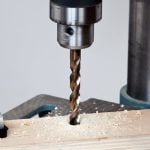When it comes to woodworking, having a good router is absolutely essential. A high-quality router can make all the difference in shaping and finishing wood with precision and efficiency. Whether you’re a professional woodworker or a hobbyist looking to tackle some DIY projects, investing in the right router can greatly enhance your woodworking experience.
A good router serves as a versatile tool that allows you to create intricate designs, smooth edges, and cut precise grooves in wood. It is an indispensable tool for any craftsman who wants to achieve professional-grade results. With various types of routers available on the market, choosing the right one for your woodworking needs requires careful consideration.
When selecting a router for woodworking, there are several key considerations to keep in mind. The type of router (fixed base, plunge base, or combo) plays a crucial role in determining its usability for different tasks. Motor power and speed are also important factors to consider, as they affect the efficiency and effectiveness of the router. Additionally, ergonomics, weight, and ease of use should not be overlooked as they contribute to user comfort and control.
Overall, finding the perfect router for your woodworking projects can be overwhelming given the wide range of options available. However, by understanding the importance of a high-quality router and considering specific factors such as type, motor power, and ergonomics; you will be well on your way to selecting a reliable tool that will meet your woodworking needs effectively.
Key Considerations When Choosing a Router for Woodworking
When it comes to choosing a router for woodworking, there are several key considerations that you need to keep in mind. The right router can make a significant difference in the quality of your woodworking projects, so it’s important to select one that suits your needs and preferences. Here are some important factors to consider when making your decision:
- Types of Routers: There are different types of routers available, including fixed base routers, plunge base routers, and combo routers. Fixed base routers are the most common type and they provide stability and precision for tasks such as edge routing and making straight cuts.
Plunge base routers, on the other hand, allow for easy depth adjustments and are ideal for tasks like cutting grooves and mortises. Combo routers offer the versatility of both fixed and plunge bases. - Motor Power and Speed: The motor power of a router determines its cutting performance. Higher horsepower allows for smoother cuts through dense materials. Additionally, the speed at which the router operates is crucial in achieving precise results. Look for routers with variable speed control, as this allows you to adjust the speed according to different woodworking tasks or material types.
- Ergonomics, Weight, and Ease of Use: Woodworking can involve prolonged periods of working with a router, so it’s important to choose one that feels comfortable in your hands. Consider factors such as grip design, handle position, and overall ergonomics when making your decision. The weight of the router also plays a role in ease of use – lighter routers are generally easier to maneuver but may sacrifice stability.
To make an informed decision about which router is best suited for your needs, it’s important to take these considerations into account as they directly impact your woodworking experience. By selecting a router that aligns with your specific requirements in terms of type, power and speed capabilities, ergonomics and ease-of-use features; you will be able to achieve better results in shaping and finishing wood.
Whether you are a professional woodworker or a hobbyist, investing in a high-quality router is essential for ensuring the success of your woodworking projects.
Top Router Brands Recommended by Woodworking Experts
Woodworking experts highly recommend several top router brands for their high-quality and reliable routers. These brands have established a reputation for producing routers that deliver exceptional performance and durability, making them popular choices among professional woodworkers. Here are some of the top router brands that come highly recommended:
Porter-Cable
Porter-Cable is a well-known brand in the woodworking industry, renowned for its range of high-quality routers. Their routers are known for their power, precision, and ease of use. Many woodworkers appreciate the excellent motor power and precision depth adjustment features offered by Porter-Cable routers. Additionally, they have a wide selection of models to choose from, catering to different needs and budgets.
Bosch
Bosch is another reputable brand that consistently delivers top-notch routers. They are known for their innovative features and cutting-edge technology that enhance accuracy and user experience. One notable feature found in Bosch routers is their advanced dust collection system, which helps keep the workspace clean and prolongs the lifespan of the router.
DeWalt
DeWalt is a trusted name in the woodworking community, offering a wide range of routers suitable for both beginners and professionals alike. DeWalt’s routers excel in terms of power and versatility, allowing woodworkers to tackle various tasks with ease. The brand’s routers also come equipped with advanced safety features such as electronic speed control and multiple base options.
These are just a few examples of the top router brands recommended by woodworking experts. Other notable brands include Makita, Festool, and Milwaukee, each offering their unique set of features and advantages. It is important to consider factors such as budget, specific woodworking needs, and personal preferences when choosing a router from these reputable brands.
Customer reviews and ratings can also be valuable resources when making a decision as they provide insights into real-world experiences with the routers. By selecting a router from one of these top brands, woodworkers can have confidence in their choice and expect excellent performance and reliability for their woodworking projects.
Best Router Models for Woodworking Projects
When it comes to finding the best router models for woodworking projects, there are several options that professional woodworkers highly recommend. These routers offer exceptional performance, versatility, and durability, making them ideal choices for a wide range of woodworking tasks. Here are some of the top router models preferred by experts in the field:
- Porter-Cable 690LR – The Porter-Cable 690LR is a fixed base router known for its reliability and power. With its 11-amp motor, this router provides ample power to tackle various woodworking tasks. It also features an adjustable speed control that allows users to match the speed to their specific needs. The Porter-Cable 690LR is praised for its durability and ease of use, making it a popular choice among woodworkers.
- Bosch 1617EVSPK – The Bosch 1617EVSPK is a versatile combo router that offers both a fixed base and plunge base. This gives woodworkers the flexibility to handle different types of cuts and depths. It has a powerful 12-amp motor and variable speed control, allowing users to adjust the speed based on their project requirements. The Bosch 1617EVSPK is lauded for its precision and smooth operation, making it a favorite among woodworking professionals.
- DeWalt DW618PK – The DeWalt DW618PK is another highly recommended combo router that offers both fixed and plunge bases. This router boasts a powerful 2-1/4 horsepower motor, providing ample strength for demanding woodworking tasks. It features electronic variable speed control to ensure consistent performance across different materials and cutting applications. The DeWalt DW618PK is commended for its solid construction and user-friendly design.
These router models not only come from reputable brands but also offer excellent features and capabilities that cater to various woodworking needs. Whether you’re working on joinery, shaping edges or creating intricate designs, these routers can provide the precision and power required for high-quality woodworking results.
Exploring the Different Router Bits Used for Woodworking
One of the most important components of a router for woodworking is the router bit. Router bits are responsible for cutting and shaping the wood, allowing woodworkers to achieve desired outcomes in their projects. Understanding the different types and profiles of router bits can greatly enhance woodworking capabilities and enable woodworkers to create intricate and professional-looking designs.
There are various types of router bits available, each designed for specific woodworking tasks. Some common types include straight bits, round-over bits, dado bits, chamfer bits, and flush trim bits. Straight bits are versatile and commonly used for cutting straight lines or grooves in the wood. Round-over bits are ideal for creating rounded edges or decorative profiles on the wood.
Dado bits are used to cut grooves into the wood to accommodate other pieces or create joints. Chamfer bits are used to create angled edges or beveled cuts on the wood. Flush trim bits are perfect for trimming excess material or making two surfaces flush with each other.
In addition to the different types, router bits also come in various profiles that determine the shape and design of the cut they produce. Some popular router bit profiles include straight, round-over, cove, ogee, and Roman ogee. Each profile creates a unique look on the wood and offers different possibilities for decorative edges or intricate designs.
Having a variety of router bits in your collection can greatly expand your capabilities as a woodworker. It allows you to experiment with different styles and designs, producing custom pieces that stand out. Investing in high-quality router bits ensures clean cuts and prolongs their lifespan, saving you money in the long run.
| Router Bit Type | Description |
|---|---|
| Straight Bits | Versatile type ideal for cutting straight lines or grooves. |
| Round-over Bits | Best for creating rounded edges or decorative profiles. |
| Dado Bits | Used to cut grooves in the wood to accommodate other pieces or create joints. |
| Chamfer Bits | Creates angled edges or beveled cuts on the wood. |
| Flush Trim Bits | Ideal for trimming excess material or making two surfaces flush with each other. |
Essential Router Accessories for Enhanced Woodworking Experience
When it comes to woodworking, having the right tools and accessories can greatly enhance your overall experience and the quality of your projects. In addition to choosing a high-quality router, there are several essential accessories that can take your woodworking to the next level.
- Router Tables: A router table provides stability and support for your router, allowing you to make precise cuts and adjustments. It also enables you to work on larger pieces of wood or perform complex routing tasks with ease. Look for a router table that is sturdy, has a spacious work surface, and features adjustable fences for added versatility.
- Edge Guides: An edge guide is an invaluable accessory that helps you maintain consistent and accurate cuts along the edges of your workpiece. It ensures straight lines and prevents any unwanted deviations or mistakes. Look for an edge guide that is compatible with your router model and offers fine-tuning capabilities.
- Jigs: Jigs are specialized accessories designed to help you achieve specific woodworking tasks more efficiently. They can be used in conjunction with your router to create intricate joinery, cut mortises, shape curves, or create repetitive patterns. Some commonly used jigs include dovetail jigs, box joint jigs, and circle cutting jigs.
- Dust Collection Systems: Woodworking can generate a significant amount of sawdust and debris, which can be harmful if inhaled or create a messy work environment. A dust collection system helps minimize dust particles by extracting them directly from the source while you’re using the router. Look for a dust collection system that is compatible with your router model and offers efficient suction power.
- Router Templates: Templates are pre-designed patterns or shapes that you can use as guides when routing specific designs or profiles onto your workpiece. They ensure consistency and accuracy throughout the project, particularly when creating decorative shapes or intricate details.
By investing in these essential router accessories, you can improve precision, safety, and efficiency in your woodworking projects. Each accessory plays a specific role in enhancing the capabilities of your router, allowing you to achieve professional-level results. Remember to choose accessories that are compatible with your router model and meet your specific woodworking needs.
Tips and Techniques for Using a Router in Woodworking
Using a router in woodworking projects requires not only the right equipment but also knowledge and skills to achieve desired outcomes. In this section, we will provide you with some valuable tips and techniques on how to effectively and safely use a router for woodworking.
Firstly, it is essential to have a clear understanding of the basic functions of a router. A router can be used for tasks such as edge routing, dado cutting, making decorative profiles, and more. When performing these tasks, it’s crucial to maintain control over the tool and workpiece at all times. Start by securing the workpiece firmly with clamps or using non-slip mats to prevent any movement or slippage during routing.
One important technique is called climb cutting. Climb cutting involves moving the router against the rotation of the bit. While this technique may be useful in certain situations, it can also be dangerous if not performed correctly. It is generally recommended for experienced woodworkers who have a solid grip on their routers and are familiar with the potential risks involved.
Another essential aspect of using a router is choosing the appropriate speed setting for your project. Most routers come equipped with variable speed control, allowing you to adjust the RPM (revolution per minute) according to your needs. Lower speeds are typically ideal for harder woods or when using larger bits, while higher speeds are suitable for softer woods or when using smaller bits.
In addition to mastering various techniques, it’s important to ensure safety while working with a router. Always wear protective gear such as safety glasses or goggles to protect your eyes from flying debris. Use push blocks or sticks when feeding stock through the router table to keep your hands away from moving parts.
By following these tips and techniques, you can maximize your productivity and achieve professional-quality results when using a router in woodworking projects. Remember that practice makes perfect, so don’t be discouraged if you encounter challenges initially. With time and experience, you will gain confidence in using the router to its full potential.
Budget-Friendly Options for Hobbyist Woodworkers
Whether you’re new to woodworking or simply working on a tight budget, there are still plenty of options available to you when it comes to selecting a router for your projects. While high-end routers may offer advanced features and capabilities, there are several budget-friendly options that can deliver quality results without breaking the bank.
One brand that consistently offers routers at affordable prices is Porter-Cable. Known for their reliable and durable tools, Porter-Cable routers are often favored by hobbyist woodworkers due to their affordability and decent performance.
The Porter-Cable 690LR is a popular model that comes with a 1-3/4 horsepower motor, variable speed control, and a single-speed router with soft-start feature. This router offers reliable power for most woodworking tasks and is considered one of the best budget-friendly options on the market.
Another brand worth considering for budget-conscious woodworkers is Craftsman. Craftsman routers are known for their affordability as well as their versatility. The Craftsman Evolve 28212 router combines good performance with an attractive price point. It features a 1-3/4 horsepower motor, variable speed control, and easy depth adjustment mechanism. This router is highly recommended for beginners or hobbyist woodworkers who don’t need heavy-duty capabilities but still want quality results.
For those willing to explore the used market, finding a second-hand router can be an excellent way to save money while still acquiring a good quality tool. Websites like Craigslist or eBay often have listings for used routers in good condition at significantly lower prices than buying new. However, it’s important to thoroughly research the specific model before purchasing and ensure that it meets your needs.
When it comes to finding the perfect budget-friendly router, keep in mind that value should not be solely determined by price alone. It’s essential to consider factors such as durability, functionality, and compatibility with other accessories you may already own or plan on purchasing in the future.
| Brand | Model | Price Range (USD) |
|---|---|---|
| Porter-Cable | 690LR | $100-$150 |
| Craftsman | Evolve 28212 | $80-$120 |
Conclusion
In conclusion, choosing the perfect router for your woodworking projects is a crucial decision that can greatly impact the quality of your work. Throughout this article, we have discussed the importance of having a high-quality router and explored key considerations when selecting one. We have also provided recommendations for top router brands and models preferred by woodworking experts.
When choosing a router, it is important to consider factors such as the type of router (fixed base, plunge base, or combo), motor power, speed control, ergonomics, weight, and ease of use. Reputable brands like Porter-Cable, Bosch, and DeWalt have been recommended by experts in the field for their reliable routers.
Additionally, we have delved into the different router bits used in woodworking and highlighted their significance in achieving desired outcomes. Furthermore, we discussed essential accessories like router tables, edge guides, jigs, and dust collection systems that can enhance the functionality of your router.
Lastly, we addressed budget-friendly options for hobbyist woodworkers who may be new to the craft or working with limited funds. By sharing affordable router options without compromising on quality or essential features and providing tips on finding good deals or second-hand routers that still meet standards, we hope to cater to a wide range of readers.
Frequently Asked Questions
What is the best use of router in woodworking?
The best use of a router in woodworking is for shaping and detailing wood. Routers are incredibly versatile tools that can create intricate patterns, decorative edges, and smooth finishes on wooden surfaces.
They can be used for tasks such as trimming, chamfering, grooving, and creating dovetail joints. By using different router bits, woodworkers can achieve various effects and designs, making the router an essential tool for adding finesse and precision to their projects.
How big of a router do I need for woodworking?
The size of the router needed for woodworking depends on the scale and complexity of the projects you plan to undertake. Generally, there are two main sizes of routers: compact or trim routers and full-sized routers. Compact routers are smaller and lighter, making them more maneuverable and ideal for lighter-duty tasks or handheld operations. They are suitable for working on smaller projects or when precision is required in tight spaces.
On the other hand, full-sized routers are more powerful with larger collets that can accommodate a wider range of bits. These routers enable you to handle more significant projects such as making raised panel doors or creating complex joinery. Ultimately, the size of the router should be chosen based on your specific needs and the scale of your woodworking projects.
How do I choose a wood router?
When choosing a wood router, several factors should be taken into consideration to ensure it meets your woodworking needs adequately. One crucial aspect is power – you’ll want a router with sufficient horsepower to handle your intended applications without strain.
The speed control options available on a router should also be evaluated; variable speed control allows adjusting the RPM (revolutions per minute), allowing for versatility in working with different materials or using various bit sizes efficiently. Additionally, considering ergonomics is important since comfort during prolonged use is crucial – opt for routers that feel comfortable in your hands and provide good balance while operating them.

Hi everyone! I’m a woodworker and blogger, and this is my woodworking blog. In my blog, I share tips and tricks for woodworkers of all skill levels, as well as project ideas that you can try yourself.





